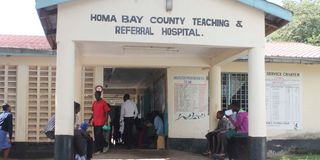Deathtraps? Pregnant women wary of Homa Bay hospitals

Homa Bay County Referral Hospital, where a KCSE candidate died after child birth.
What you need to know:
- The latest case involved a Form Four student, who died on Monday after delivering at the County Teaching and Referral Hospital.
- Governor Gladys Wanga on Tuesday ordered investigations into her death.
Childbirth in Homa Bay hospitals is still the biggest headache for most pregnant women.
Residents now consider successful delivery in county hospitals a miracle. Some pregnant women do not come out the facilities alive. Some grapple with the grief or guilt of stillbirth. Medics have rejected accusation of negligence.
The latest case involved19-year-old Form Four student Velma Anita Ochieng, who died on Monday after delivering at the County Teaching and Referral Hospital. The exact cause of her death has yet to be established.
Governor Gladys Wanga on Tuesday visited the bereaved family on Tuesday to condole with them. She ordered investigations into her death. The Health department and the Curative Services Committee of the hospital’s board will work separately and come up with answers that will enable the devolved unit to address cases of maternal and infant deaths. She said necessary steps and actions will follow the probe.
Ms Wanga’s administration came under criticism on Monday when news about the student’s death broke. Different people took to social media to express their displeasure at how the county health system is managed. They accused the governor of not doing enough to fix the ailing sector.
Protecting lives
But Ms Wanga defended her administration, saying it had put in place measures to protect lives. “Since coming into office three months ago, we have taken serious measures to ensure we provide quality care to all residents of Homa Bay at the County Teaching and Referral Hospital,” she said.
She further assured residents that doctors would henceforth work round the clock to ensure no mother dies while delivering, “especially if it can be avoided”. “One life lost is one too many.”
Hospital Chief Executive Officer Peter Ogolla rejected claims that medics at the facility were sleeping on the job, saying the student underwent successful surgery before she died.
Velma was to sit her KCSE exam at Nyajanja Mixed Secondary School in Kochia, Rangwe, from this week. She was admitted to hospital on Saturday at 5pm when she started experiencing labour pain.
Her aunt, Selah Ayaga, said she was in a lot of pain. “She was taken to the hospital on a motorcycle. We faced difficulties after being sent away by security guards.”
'Pleas ignored'
Pleas by Velma’s family to have her taken to the theatre later in the night were allegedly dismissed by medics. “She was crawling while nurses were asleep. They appeared to be demotivated,” Ms Ayaga said.
A doctor’s report, however, said she was supposed to deliver on December 7 and had to stay in hospital until she was due.
Dr Ogolla said the student was examined by medics and found to be in the early stages of delivery. “Her cervix dilation was two centimetres when the recommended size is 10cm. Her dilation got stuck at five centimetres throughout the time she was in hospital,” he said.
He said health workers were monitoring her after every four hours as they normally do for those at the maternity ward. After the third examination, medics discovered that her cervical could not expand further. It meant she could not deliver normally.
According to Dr Ogolla, the doctor who conducts the Cesarean section was attending to two other patients at the time. “Nurses informed the doctor of the condition of the patient and he advised that the student be taken to the theatre,” he said.
Abdominal pain
In a report by the doctor, he performed successful surgery and the patient was taken back to the ward with her male newborn. But her condition deteriorated thereafter as she complained of pain in her lower abdomen.
“It is normal for one to feel pain at the incision sites. The patient was restless two hours after the operation,” Dr Ogolla explained.
To reduce the pain, they gave her painkillers, which, Dr Ogolla said, did not work. Velma was also having low blood pressure (90/50), which medics tried in vain to stabilise. “They checked for outward bleeding that could lead to the fall in pressure. Within 30 minutes, her vital organs became unresponsive and she died,” Dr Ogolla said.
Velma's body was taken to the hospital’s mortuary.
Dr Ogolla said they had yet to establish what caused the blood pressure to fall rapidly. “The baby scored well. He was 3.6 kilogrammes,” he said.





